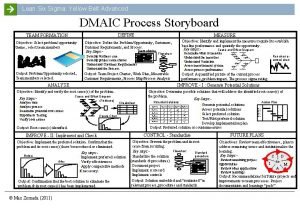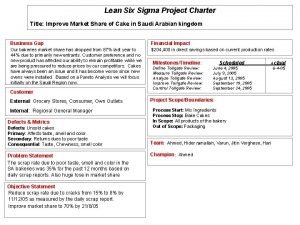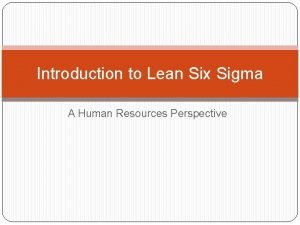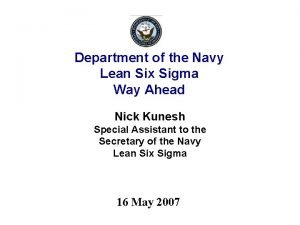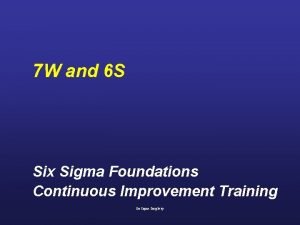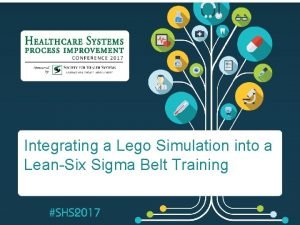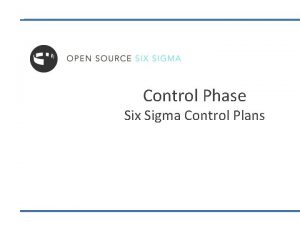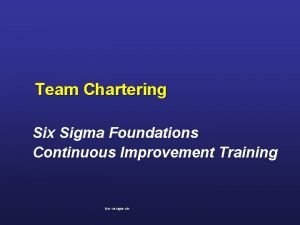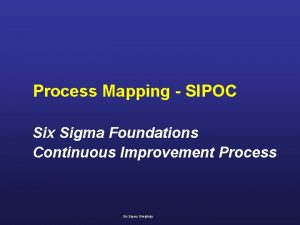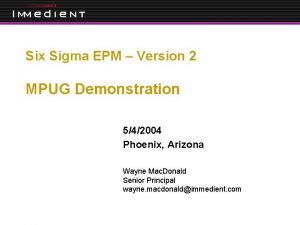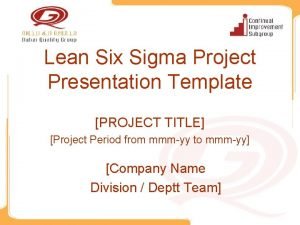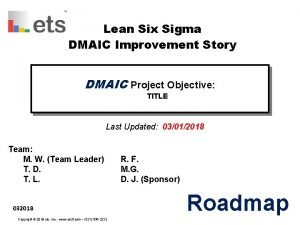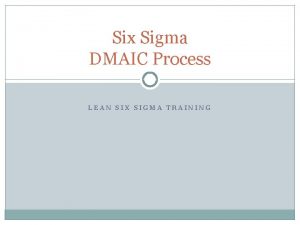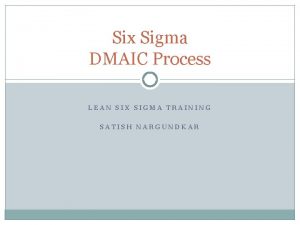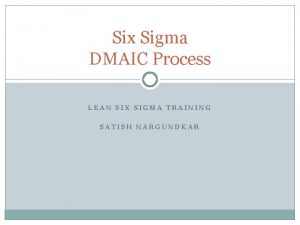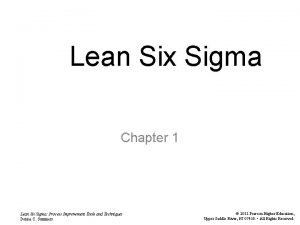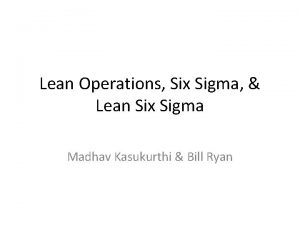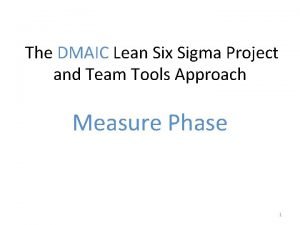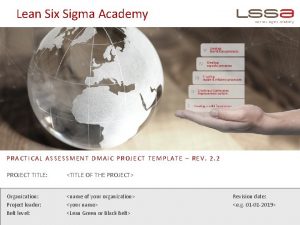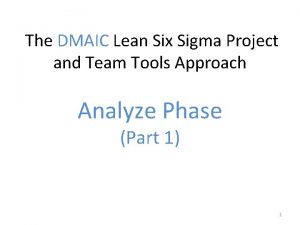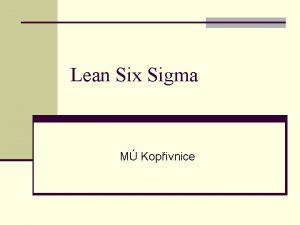Lean Six Sigma DMAIC Improvement Story DMAIC Project
















- Slides: 16

Lean Six Sigma DMAIC Improvement Story DMAIC Project Objective: TITLE Last Updated: 03/01/2018 Team: M. W. (Team Leader) T. D. T. L. 032018 Copyright © 2018 ets, inc. - www. etsfl. com – (321) 636 -2212 R. F. M. G. D. J. (Sponsor) Roadmap

Lean Six Sigma Problem Solving Process The team utilized the 5 -Step DMAIC problem solving process. Process Step Number 1 2 3 4 5 Description of Key Team Activities Name DEFINE Select Priority Issue / Process Confirm Stakeholder Requirements Display Theme Indicator and Performance “Gap” Develop a SMART Theme Statement Determine the Cost of Poor Quality Establish a Method to Monitor Team Progress Develop a DMAIC Project Schedule MEASURE Construct a Process Flow Chart Perform 8 Wastes Analysis Develop a Data Collection Plan Stratify the Problem (i. e. “Gap”) and Select the Significant Problem Develop a Target and a SMART Problem Statement ANALYZE Identify Potential Root Causes(s) Verify Root Cause(s) Assess Impact of Root Causes on the Problem in the Measure Step IMPROVE Identify and Select Countermeasures Identify Barriers and Aids Develop Action Plans Confirm Pilot Plan Effectiveness and Document Lessons Learned Determine the Expected Return on Investment CONTROL Confirm / Document Improvement Results Determine the Actual Return on Investment Standardize Improvements within Operations Replicate Changes Document Lessons Learned Identify Future Plans for Continued Process Improvement Note: Keep sponsor informed and engaged. Define Measure Analyze Improve Control 1

Monitor Team Progress The team and management used a Checklist to monitor team progress. ets Six Sigma DMAIC Checklist Step DMAIC Steps – Objectives and Checkpoints Key Tools / Techniques Quantify the need for improvement in terms of performance and financial impact. Step 1: Define 1. The stakeholders and needs were identified. 2. An indicator measuring performance in meeting the need was developed. 3. A theme statement consistent with the indicator was developed, and the Cost of Poor Quality (COPQ) were determined. 4. A schedule for completing the five DMAIC steps was developed. 5. The sponsor signed off on the project’s purpose, scope, and significance. Selection Matrix Line Graph Theme Statement Cost of Poor Quality Matrix Action Plan Project Charter Project Planning Worksheet Identify the significant problem and set a target for improvement. Step 2: Measure 6. Measurement and data collection systems were developed. 7. The theme was stratified from various viewpoints and a significant problem was chosen. 8. A target for improvement was established based on the stakeholders’ needs. 9. The impact of the target on theme indicator and the COPQ were determined. 10. A problem statement that addressed the gap between the actual and target values was developed. 11. The sponsor signed off on the project’s focus and target. Define Measure Analyze Improve Control Process Flow Chart 8 Wastes Checksheet, Spreadsheet, Survey Histogram Pareto Chart Target Setting Worksheet Problem Statement 2

Monitor Team Progress ets Six Sigma DMAIC Checklist Step DMAIC Steps – Objectives and Checkpoints Key Tools / Techniques Identify and verify the root causes of the problem. Step 3: Analyze 12. Cause and effect analysis was taken to the root level. 13. Potential causes most likely to have the greatest impact on the problem were selected. 14. A relationship between the root causes and the problem was verified with data. 15. The impact of each root cause on the gap and the COPQ were determined. 16. The sponsor signed off on the verified root causes and impact on the gap. Cause and Effect Diagram (Fishbone) 5 Whys Qualitative Analysis Single Case Bore Analysis Chi Square Test Root Cause Verification Matrix Select and plan effective and feasible countermeasures and determine the expected Return on Investment. Step 4: Improve 17. Countermeasures were selected to address verified root causes. 18. The method for selecting the appropriate practical methods was clear and considered effectiveness and feasibility. 19. Barriers and Aids were determined for countermeasures worth implementing. 20. The action plan reflected accountability, schedule, and cost. 21. A test pilot plan was implemented and evaluated to determine the capability to achieve the target established in the Problem Statement. 22. Lessons learned from the pilot were incorporated into the full-scale action plan, and the project’s expected Return on Investment (ROI) was calculated. 23. The sponsor signed off on the action plan and expected results. Define Measure Analyze Improve Control Countermeasures Matrix Work Breakdown Structure Barriers and Aids Analysis Cost Benefit Analysis Action Plan Pilot/Simulated Pilot Lessons Learned Return on Investment 3

Monitor Team Progress ets Six Sigma DMAIC Checklist Step DMAIC Steps – Objectives and Checkpoints Key Tools / Techniques Step 5: Control Confirm the results including the actual Return on Investment, standardize the changes, and develop future plans. Evaluate the results by confirming that the countermeasures Before and After implemented impacted the root causes, the problem, and the Theme Results Graphs Indicator, and determine the actual Return on Investment. Process Control System 24. The effects of countermeasures on the root causes were demonstrated. Radar chart 25. The effects of countermeasures on the problem were demonstrated. Results Action Plan (for Phase 26. The improvement target was achieved and causes of significant variation Future Plans / Next were addressed. Steps) 27. The effects of countermeasures on theme indicator representing the Management stakeholders’ needs were demonstrated, and the project’s actual ROI Presentation was calculated. Ensure process revisions are incorporated into standard work, including replication in all applicable areas. 28. A method was established to document, permanently change, and Standardization communicate the revised process or standard. Phase 29. Responsibility was assigned and periodic checks scheduled to ensure compliance with the revised process or standard. 30. Specific areas for replication were identified. Document lessons learned and develop plans for the next process improvement cycle. 31. Any remaining problems of theme were addressed. Future Plans Phase 32. Lessons learned, P-D-C-A of the ets DMAIC Method, and team growth were assessed and documented. 33. The sponsor signed off on the results and next steps. Define Measure Analyze Improve Control 4

Essential Tools The team … Identified Stakeholders and their Needs. Confirmed alignment to organization’s KPIs. (Scorecard and/or Strategic Plan). 1. Created a Theme Indicator (Line Graph) for performance. 2. Developed a SMART Theme Statement consistent with the Theme Indicator (Line Graph). Determined the Cost of Poor Quality of the “gap”. 3. Developed a Project Charter and DMAIC Schedule. 4. Achieved Sponsor Sign-off. 5. Define Measure Analyze Improve Control 5

Define Step Roadmap Define Measure Analyze Improve Control 6

Essential Tools The team … Constructed a Process Flow Chart and applied the 8 Wastes. Developed a Checksheet / Spreadsheet or Survey to collect data. 6. Created a Histogram (if measurable data). Developed a Pareto Chart to prioritize problems. Selected the significant problem. 7. Set a target for the problem (big bar on the Pareto Chart). 8. Determined how much achieving the target on the problem (big bar) will impact the Theme Indicator. 9. Developed a SMART Problem Statement. 10. Achieved Sponsor Sign-off. 11. Define Measure Analyze Improve Control 7

Measure Step Roadmap Define Measure Analyze Improve Control 8

Essential Tools The team … Developed a Cause & Effect Diagram (Fishbone) to identify potential causes and applied 5 Whys. 12. Selected most likely potential causes. Performed Qualitative Analysis for potential “Quick Wins”. 13. Conducted Root Cause Verification using Statistical Tools. 14. Assessed the impact of verified root causes on the Problem (big bar on Pareto Chart) target in the MEASURE step. 15. Achieved Sponsor Sign-off. 16. Define Measure Analyze Improve Control 9

Analyze Step Roadmap Define Measure Analyze Improve Control 10

Essential Tools The team … Developed a Countermeasures Matrix and Selected Countermeasures to Address Root Causes. 17. Evaluated Practical Methods for effectiveness and feasibility. 18. Applied Work Breakdown Structure and Performed Barriers and Aids Analysis. 19. Conducted Cost Benefit Analysis. Reviewed and updated COQP from DEFINE step. Developed Action Plan. 20. Conducted a Pilot Project (An actual pilot or simulation). 21. Documented lessons learned from the Pilot. Documented lessons learned from the Project. Calculated Expected Return on Investment (ROI). 22. Achieved Sponsor Sign-off. 23. Define Measure Analyze Improve Control 11

Improve Step Roadmap Define Measure Analyze Improve Control 12

Essential Tools The team … 24. & 25. 26. & 27. Developed Before and After Graphs (using graphs shown in the Analyze, Measure, and Define steps in reverse order). Determined Actual Project Return on Investment (ROI). Updated the Process Flow Chart and revised procedures. Provided training in new procedures. Updated and implemented the Process Control System. Monitored compliance with new methods. 29. Identified Replication Opportunities. 30. Developed an Action Plan for Future Plans / Next Steps. 31. Documented overall project lessons learned / team growth. 32. Achieved Sponsor Sign-off. 33. Team made its Management Presentation, received Recognition. Define Measure Analyze Improve Control 28. 13

Control Step Roadmap Define Measure Analyze Improve Control 14

Appendix Use the Appendix for: Back up data and analysis documentation. Meeting minutes. Source documents and reports. Organization’s Key Performance Indicators (KPIs), Scorecard, and/or Strategic Plan. Notes: • The “Essential Tools” will be used in most DMAIC project stories. Some projects may require additional tools. • Remember: Fact-based conclusions; consistency in terminology; continuity of data; and logical story flow. 15
 Who is this
Who is this Lean six sigma forum
Lean six sigma forum Yellow belt dmaic
Yellow belt dmaic Charter lean six sigma
Charter lean six sigma Lean six sigma hr
Lean six sigma hr Navy lean six sigma
Navy lean six sigma Lean six sigma nedir
Lean six sigma nedir Sigma simplicity
Sigma simplicity Ceinture jaune lean six sigma
Ceinture jaune lean six sigma Lai lean academy
Lai lean academy Six sigma control plan
Six sigma control plan Lean six sigma foundations
Lean six sigma foundations Lean six sigma storyboard
Lean six sigma storyboard Lean six sigma foundations download
Lean six sigma foundations download Dmaic model uitleg
Dmaic model uitleg Immedient
Immedient Pilot plan template six sigma
Pilot plan template six sigma


